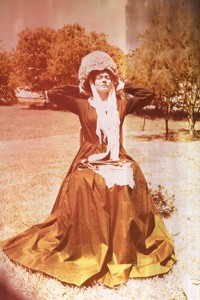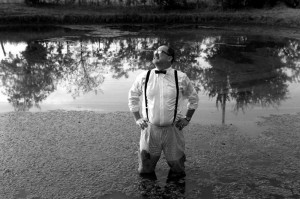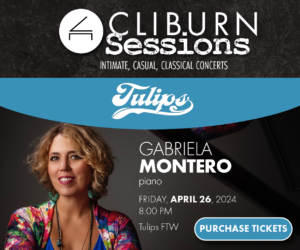Around 2000 Sale had what he calls a mid-life crisis. He stopped teaching and began full-time exploring and antiquing, all the while pondering the meaning of life, especially through spirituality.

Courtesy Tom Sale
“That’s when I created my alter-ego, Pinky Diablo,” he said. Pinky gave Tom permission to ditch high art for a time in favor of something closer to arts and crafts. He renewed his interest in sewing and embroidery, learned originally from his grandmother, Eva Loper. He met Dallas fabric artist Judy Vetter, with whom he still partners on craft projects. They host an annual “Tom and Judy Holiday Show” each December.
Sale also began collecting antique sterling silver and silver-plated spoons and drilling skeleton faces into their bowls. His “skull spoons” are internationally known and sold via Pinky’s website. Sale is proficient at watercolor painting, as is his mother. He sells watercolors of quip-spouting skeletons from a booth in a Dallas vintage and art store called Dolly Python.
As an offshoot to his spiritual quest, Sale got a state license to officiate at weddings and funerals. “Now I was Rev. Pinky,” he said. He conducted the high-end wedding (in Maine) of Dallas gallery owner Barry Whistler to photographer Allison V. Smith. He married Sara Rice and Luis Martinez at last year’s State Fair.
“I dressed as Big Tex,” Sale said, laughing. “And I got our pictures in the paper.”
These days, he has put aside parts of the Pinky Diablo identity, keeping only “the ones I need.” He is content to teach art again, as long as he can make time for his other projects. And Hill College, after all, figures into “The Florence Project” in a big way. The college believed enough in his vision to finance a trip to Turkey, where Nightingale did her most famous work.
********
Sale was on a summer break from teaching when he started helping a friend do research for her trip to Turkey. In looking up factoids for her about the Ottoman Empire, he became fascinated with the Crimean War of the 1850s — a struggle among European powers, Russia, and the Turks for control of the Middle East. He also became keenly interested in Nightingale’s work during that conflict, in which soldiers on all sides were as likely to die of disease as from their wounds.
Sale applied for and received a Hill College Faculty Study Grant to go to Istanbul and research “both the current city and the places Nightingale visited while working there,” he said. The resulting trip in 2011 provided fodder and mental energy for the lengthy art project.
“This was a tremendous time in the part of the world that was called Constantinople, now Istanbul. There was a sophisticated culture, complex city life and worldwide trade, and, eventually, a great war.” Sale said. Constantinople was the showplace of the sultans at the center of the Ottoman Empire, straddling Europe and Asia.
Nightingale came from a well-off English family with liberal ideas, but she broke away even from them to study nursing. When the war began, she answered the call for nurses to go to the front.

“Florence, in her take-charge organizational style, put together a team of nurses and nuns,” Sale said. “They arrived in Constantinople in the fall of 1854 to find filthy, horrid conditions in this huge, makeshift hospital. Nightingale immediately and defiantly alienated herself from the laissez-faire British army doctors. She reorganized and cleaned up the army hospitals under her charge.” Nightingale encouraged medical education for women so they would be accepted for serious work and became known for her improvements to hospitals, clinics, sanitary practices, and standards of healthcare.
“You don’t have to know too much about history or Florence or the Crimean War or the Ottoman Empire to enjoy my show,” Sale said. In fact, he suggests viewing the exhibit without doing any research. “It’ll be more fun that way, more quizzical.”
Although Sale clearly loves telling Nightingale’s story, his exhibit is not a particularly good way to learn the facts about her. To Sale, the facts are just a beginning, and the texts that accompany the various maps, casts, shadow boxes, and montages of found objects are about half fiction. The idea that people will try to figure out which parts are true seems to delight him.
For instance, in the text accompanying one assemblage, he describes how Nightingale collected shells and natural artifacts and then segued into collecting “medical specimens, often animal fetuses for which she delighted in making tiny clothes with the ‘skills of upper-class ladies’ she had begrudgingly learned from her mother.”
“I see it in my head as a movie. I have from the beginning,” he said. “If I had the wherewithal, I would want to show it that way.”
As he worked to decide how to tell the story swirling in his imagination, he said, he tried to write it as a book.
“I couldn’t do it. I finally said, ‘Screw it!’ Some of [the exhibit] is in my voice — some in pictures, some in drawings, some in sculpture, and some assembled from collected things from the ’net.”
“Assemblage,” in fact, is what John Lunsford, former director of the Southern Methodist University’s Meadows Museum and former curator at the Dallas Museum of Art, calls Sale’s latest exhibit.
“If you have to put a label on it,” Lunsford said, “I would also call it transformational art, since he transforms found material. He is exceedingly complex. He wants this work to mean something.” Lunsford said he’s been close to Sale and his work for more than a decade.
The former museum director said Sale’s work also tends toward surrealism. And he finds a striking comparison between Sale and Dadaist artist Max Ernst. “Ernst worked in collage, but I see the similarities in how they chose to express a unique vision,” Lunsford said.
********












Tom Sale is an inspiration.
Fresh out of high school I was lucky to have a class at UNT conducted by Mr. Sale, and it undoubtably help set me in the right direction.
Huge fan.
Future Eagle Don Henley & I were lucky enough to have Tom Sale’s dad (Dr. Richard Sale) as a professor at North Texas.